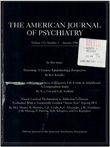Symptom differences in major depression, dysthymia, panic disorder, and generalized anxiety disorder
Abstract
OBJECTIVE: The authors compared symptom features of specific subtypes of depressive and anxiety disorders. METHODS: Psychiatric outpatients with moderate levels of psychopathology and DSM-III diagnoses of major depression, dysthymia, panic disorder, or generalized anxiety disorder were given five standard measures of symptoms of anxiety and depressive disorders. Most of the outpatients were white, and most were middle- class. RESULTS: Principal components analysis revealed 12 orthogonal symptom components. Discriminant function analysis indicated that anxiety was distinguished by specific autonomic arousal symptoms, threat-related cognitions, and subjective anxiety and tension. Discriminant function analysis also indicated that depression was distinguished by anhedonia, cognitions of personal loss and failure, and dysphoric mood. CONCLUSIONS: As nosological categories, major depression and panic disorder were better differentiated by specific symptom markers than dysthymia and generalized anxiety disorder.
Access content
To read the fulltext, please use one of the options below to sign in or purchase access.- Personal login
- Institutional Login
- Sign in via OpenAthens
- Register for access
-
Please login/register if you wish to pair your device and check access availability.
Not a subscriber?
PsychiatryOnline subscription options offer access to the DSM-5 library, books, journals, CME, and patient resources. This all-in-one virtual library provides psychiatrists and mental health professionals with key resources for diagnosis, treatment, research, and professional development.
Need more help? PsychiatryOnline Customer Service may be reached by emailing [email protected] or by calling 800-368-5777 (in the U.S.) or 703-907-7322 (outside the U.S.).



